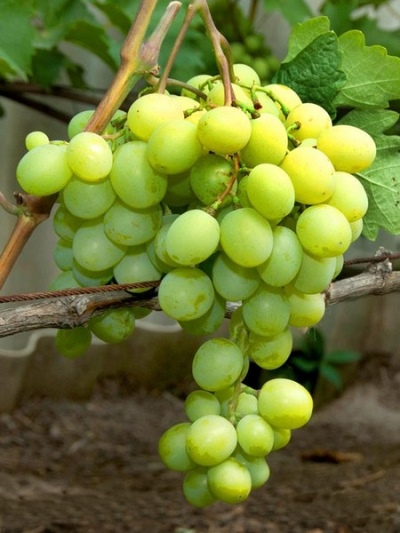
- Authors: Pisanka O. M.
- Appointment: dining room
- Berry color: amber
- Taste: nutmeg
- Ripening period: very early
- Ripening period, days: 95-100
- Frost resistance, ° C: -23
- Bunch weight, g: 1000-2000
- Flower type: functionally female
- Peeling: No
Grapes are a heat-loving and capricious plant. But thanks to the work of breeders, today it is possible to grow this useful crop even in the most severe climatic conditions. Valuable not only for its taste, but because of the special composition of nutrients and vitamins.
Breeding history
The Krasavchik grape is a new complex interspecific hybrid obtained by crossing seedlings from free pollination of the Kesha-1 variety by the well-known private Ukrainian breeder Pysanka O.M.
Description
The plant is vigorous, with a good root system. The leaves are large, colored deep green. The vine ripens completely. Belongs to table varieties with good commercial characteristics.
Ripening period
A very early variety, technical ripeness occurs in 95-100 days from the beginning of flowering. The first ripe fruits can be enjoyed at the beginning of August.
Bunches
Medium loose to moderate density, very large. One bunch can weigh from 1000 to 2000 g.
Berries
The shape of the fruit is weakly oval, with a fleshy juicy pulp and a loose, easily eaten skin. The color of ripe berries is amber. The weight of one berry reaches an average of 12-14 g.
Taste
The grape has a very pleasant aroma, with a pronounced nutmeg flavor. Sugar accumulation in fruits reaches 180 g / dm³, acidity is low - 5 g / dm³.
Due to the high content of juice in the pulp, the fruits are excellent for making wines and juices.
Yield
High-yielding hybrid. One bush yields more than 20 kg of berries.


Growing features
Grapes Handsome are unpretentious in care. He is not afraid of abruptly changing weather conditions. It can grow on different types of soil. A place for growing is preferable to choose a sunny, fairly open and well-ventilated, but without drafts.
The hybrid does not tolerate tightness, since the strength of growth in height and breadth is very large. Therefore, it is necessary for him to carefully select a site, prepare supports for the vine.
No need to plant near buildings and trees.
Groundwater negatively affects the development of culture. Their level should not be closer than 2 m to the surface of the earth. The variety has a very powerful root system and the depth of their growth is quite high.
Watering should be moderate. Handsome does not tolerate stagnant water.
Landing
Cuttings have a high degree of survival. They have good roots and grow quite quickly. Can be rooted both indoors and outdoors.
Pre-prepare the landing pit. It should be quite voluminous. Roots need space.Fall asleep in layers. First, drainage is created from rubble or broken brick. Then comes the sand, humus and the final layer of soil.
The root collar does not need to be deeply buried. It is necessary to leave 2 m between the seedlings, while between the rows - 3 m.

Pollination
Functionally female type of flower. The ovary is carried out almost 100%, well pollinated, with a slight pea.
Pruning
The grapes are not pruned in the first year of cultivation. They begin to remove shoots in the second year of cultivation, in the fall. A quarter of the vine is cut off (thin and weak twigs, leaves, everything that can lead to freezing of the bush).
Spring pruning involves removing dry, frozen branches. During the summer, stepchildren must be cut off so that the bush does not unnecessarily waste the necessary nutrients for their growth.



Frost resistance and the need for shelter
It can withstand frost down to -23 degrees. In order to avoid freezing of the kidneys, a prerequisite is a shelter for the winter. The vine is removed from the supports, sprinkled abundantly with dry grass, hay or sawdust, covered with foil or agrofibre. Sprinkle on top with earth or snow.

Diseases and pests
The hybrid has average immunity to most fungal diseases, especially mildew and powdery mildew. It is imperative to carry out preventive treatment with insecticides and fungicides every year. Carry out activities before and after flowering.
Wasps pose a great danger to bunches. To protect the fragrant fruits, use a net, or arrange traps for them, planting plants with a sweet smell or honey plants next to them.

If a grape is exposed to any disease or insect, this always affects its appearance.
Storage
Ripe bunches retain their presentation well for several months. They perfectly tolerate transportation without losing their properties. Harvested in dry weather. They are stored in boxes, the room should be cool, and the grapes should be arranged in one layer.











































































